Climate Change Impacts on Soil Erosion and Sediment Delivery to German Federal Waterways: A Case Study of the Elbe Basin
Abstract
1. Introduction
2. Materials and Methods
2.1. Study Site
2.2. WaTEM/SEDEM Model
2.3. Spatial Input Data
2.4. Suspended Sediment Data
2.4.1. Measured Data Availability
2.4.2. Calculation of Average Annual Suspended Sediment Loads
2.5. Model Calibration and Validation
3. Results and Discussion
3.1. Observed Avarage Annual Suspended Sediment Loads
3.2. WaTEM/SEDEM Model Calibration and Evaluation
3.3. Todays Erosion Hotspots
3.4. Simulated Future Soil Erosion and Sediment Loads
3.4.1. Changes in Rainfall Erosivity
3.4.2. Changes in Soil Erosion and Sediment Loads
4. Conclusions
- Even though they are prone to substantial errors, infrequent measurement of suspended sediment concentrations at numerous water quality assessment sites can give an estimate of spatial patterns of soil erosion and sediment delivery.
- Distributed modeling of soil erosion and sediment delivery with the WaTEM/SEDEM is very helpful to identify spatial patterns of erosion rates within large basins. Nonetheless, it is subject to considerable uncertainties.
- Uncertainties in simulated erosion rates and sediment loads associated to model parameterization are inevitable. For simulated mean erosion rates of single subbasins it was up to 60%. This uncertainty can be assessed with stochastic modeling.
- Further uncertainties about future changes in rainfall erosivity are due to differences between single members of the climate model ensemble used here and between the emission scenarios. To assess this uncertainty, it is important to use climate model ensembles instead of the output of a single model.
- Major erosion hotspots are located in the central part of the basin, in a zone stretching from the Saale catchment via the foothills of the Ore Mountains to Upper Lusatia, as well as in the foothills of the Sudetes in the northeast of the Czech part of the basin.
- Despite the uncertainties in erosion modeling, it is very likely that future erosion and sediment delivery will increase (mainly in the southeastern part of the basin) but the absolute values are highly uncertain and depend strongly on future emissions.
- Further research is needed to assess the role of erosion control practices and sediment retention measures as well as the impact of the likely future increase in extreme precipitation on future soil erosion rates.
Supplementary Materials
Author Contributions
Funding
Data Availability Statement
Acknowledgments
Conflicts of Interest
References
- Milliman, J.; Farnsworth, K. River Discharge to the Coastal Ocean: A Global Synthesis; Cambridge University Press: Cambridge, UK, 2013. [Google Scholar]
- Hackney, C.; Vasilopoulos, G.; Heng, S.; Darbari, V.; Walker, S.; Parsons, D.R. Sand mining far outpaces natural supply in a large alluvial river. Earth Surf. Dyn. 2021, 9, 1323–1334. [Google Scholar] [CrossRef]
- Koehnken, L.; Rintoul, M.; Goichot, M.; Tickner, D.; Loftus, A.-C.; Acreman, M.C. Impacts of riverine sand mining on freshwater ecosystems: A review of the scientific evidence and guidance for future research. River Res. Appl. 2020, 36, 362–370. [Google Scholar] [CrossRef]
- Wisser, D.; Frolking, S.; Hagen, S.; Bierkens, M.F.P. Beyond peak reservoir storage? A global estimate of declining water storage capacity in large reservoirs. Water Resour. Res. 2013, 49, 5732–5739. [Google Scholar] [CrossRef]
- Kondolf, G.M.; Gao, Y.; Annandale, G.W.; Morris, G.L.; Jiang, E.; Zhang, J.; Cao, Y.; Carling, P.; Fu, K.; Guo, Q.; et al. Sustainable sediment management in reservoirs and regulated rivers: Experiences from five continents. Earths Future 2014, 2, 256–280. [Google Scholar] [CrossRef]
- Owens, P.N.; Batalla, R.J.; Collins, A.J.; Gomez, B.; Hicks, D.M.; Horowitz, A.J.; Kondolf, G.M.; Marden, M.; Page, M.J.; Peacock, D.H.; et al. Fine-grained sediment in river systems: Environmental significance and management issues. River Res. Appl. 2005, 21, 693–717. [Google Scholar] [CrossRef]
- Blake, W.H.; Walsh, R.P.D.; Barnsley, M.J.; Palmer, G.; Dyrynda, P.; James, J.G. Heavy metal concentrations during storm events in a rehabilitated industrialized catchment. Hydrol. Process. 2003, 17, 1923–1939. [Google Scholar] [CrossRef]
- Bilotta, G.S.; Brazier, R.E. Understanding the influence of suspended solids on water quality and aquatic biota. Water Res. 2008, 42, 2849–2861. [Google Scholar] [CrossRef]
- Ciszewski, D.; Grygar, T.M. A review of flood-related storage and remobilization of heavy metal pollutants in river systems. Water Air Soil Pollut. 2016, 227, 239. [Google Scholar] [CrossRef] [PubMed]
- Stefanidis, S.; Alexandridis, V.; Ghosal, K. Assessment of Water-Induced Soil Erosion as a Threat to Natura 2000 Protected Areas in Crete Island, Greece. Sustainability 2022, 14, 2738. [Google Scholar] [CrossRef]
- Orgiazzi, A.; Panagos, P. Soil biodiversity and soil erosion: It is time to get married: Adding an earthworm factor to soil erosion modelling. Glob. Ecol. Biogeogr. 2018, 27, 1155–1167. [Google Scholar] [CrossRef]
- Moatar, F.; Person, G.; Meybeck, M.; Coynel, A.; Etcheber, H.; Crouzet, P. The influence of contrasting suspended particulate matter transport regimes on the bias and precision of flux estimates. Sci. Total Environ. 2006, 370, 515–531. [Google Scholar] [CrossRef] [PubMed]
- Meade, R.H. Sediment transport and deposition in rivers: The case for non-stationarity. In A Review of Selected Hydrology Topics to Support Bank Operations; World Bank: Washington, DC, USA, 2008; Volume 69. [Google Scholar]
- Mano, V.; Nemery, J.; Belleudy, P.; Poirel, A. Assessment of suspended sediment transport in four alpine watersheds (France): Influence of the climatic regime. Hydrol. Process. Int. J. 2009, 23, 777–792. [Google Scholar] [CrossRef]
- Blöthe, J.; Hoffman, T. Spatio-temporal disparities dominate suspended sediment dynamics in medium-sized catchments in central Germany. Geomorphology 2022, 418, 108462. [Google Scholar] [CrossRef]
- Sun, Y.; Solomon, S.; Dai, A.; Portmann, R.W. How often will it rain? J. Clim. 2007, 20, 4801–4818. [Google Scholar] [CrossRef]
- Brienen, S.; Water, A.; Brendel, C.; Fleischer, C.; Ganske, A.; Haller, M.; Helms, M.; Höpp, S.; Jensen, C.; Jochumsen, K.; et al. Klimawandelbedingten Änderungen in Atmosphäre und Hydrosphäre. Schlussbericht des Schwerpunktthemas Szenarienbildung (SP-101) im Themenfeld 1 des BMVI-Expertennetzwerk; Bundesministerium für Verkehr und digitale Infrastruktur (BMVI): Berlin, Germany, 2020. [CrossRef]
- Kharin, V.V.; Zwiers, F.W.; Zhang, X.; Wehner, M. Changes in temperature and precipitation extremes in the CMIP5 ensemble. Clim. Chang. 2013, 119, 345–357. [Google Scholar] [CrossRef]
- Scoccimarro, E.; Gualdi, S.; Bellucci, A.; Zampieri, M.; Navarra, A. Heavy precipitation events in a warmer climate: Results from CMIP5 models. J. Clim. 2013, 26, 7902–7911. [Google Scholar] [CrossRef]
- Fowler, H.J.; Lenderink, G.; Prein, A.F.; Westra, S.; Allan, R.P.; Ban, N.; Barbero, R.; Berg, P.; Blenkinsop, S.; Do, H.X.; et al. Anthropogenic intensification of short-duration rainfall extremes. Nat. Rev. Earth Environ. 2021, 2, 107–122. [Google Scholar] [CrossRef]
- Nearing, M.A.; Pruski, F.F.; O'neal, M.R. Expected climate change impacts on soil erosion rates: A review. J. Soil Water Conserv. 2004, 59, 43–50. [Google Scholar]
- Panagos, P.; Ballabio, C.; Meusburger, K.; Spinoni, J.; Alewell, C.; Borrelli, P. Towards estimates of future rainfall erosivity in Europe based on REDES and WorldClim datasets. J. Hydrol. 2017, 548, 251–262. [Google Scholar] [CrossRef]
- Auerswald, K.; Fischer, F.; Winterrath, T.; Elhaus, D.; Maier, H.; Brandhuber, R. Klimabedingte Veränderung der Regenerosivität seit 1960 und Konsequenzen für Bodenabtragsschätzungen. In Bodenschutz, Ergänzbares Handbuch der Maßnahmen und Empfehlungen für Schutz, Pflege und Sanierung von Böden, Landschaft und Grundwasser; Erich Schmidt Verlag: Berlin, Germany, 2019; p. 21. [Google Scholar]
- Auerswald, K.; Fischer, F.; Winterrath, T.; Brandhuber, R. Rain erosivity map for Germany derived from contiguous radar rain data. Hydrol. Earth Syst. Sci. 2019, 23, 1819–1832. [Google Scholar] [CrossRef]
- Hanel, M.; Pavlásková, A.; Kyselý, J. Trends in characteristics of sub-daily heavy precipitation and rainfall erosivity in the Czech Republic. Int. J. Climatol. 2016, 36, 1833–1845. [Google Scholar] [CrossRef]
- Panagos, P.; Ballabio, C.; Himics, M.; Scarpa, S.; Matthews, F.; Bogonos, M.; Poesen, J.; Borrelli, P. Projections of soil loss by water erosion in Europe by 2050. Environ. Sci. Policy 2021, 124, 380–392. [Google Scholar] [CrossRef]
- Borrelli, P.; Robinson, D.A.; Panagos, P.; Lugato, E.; Yang, J.E.; Alewell, C.; Wuepper, D.; Montanarella, L.; Ballabio, C. Land use and climate change impacts on global soil erosion by water (2015–2070). Proc. Natl. Acad. Sci. USA 2020, 117, 21994–22001. [Google Scholar] [CrossRef]
- Borrelli, P.; Christine, A.; Pablo, A.; Ayach, A.J.A.; Jantiene, B.; Cristiano, B.; Nejc, B.; Marcella, B.; Cerda, A.; Chalise, D.; et al. Soil erosion modelling: A global review and statistical analysis. Sci. Total Environ. 2021, 780, 146494. [Google Scholar] [CrossRef]
- Merritt, W.S.; Letcher, R.A.; Jakeman, A.J. A review of erosion and sediment transport models. Environ. Model. Softw. 2003, 18, 761–799. [Google Scholar] [CrossRef]
- Batista, P.; Davies, J.; Silva, M.L.N.; Quinton, J.N. On the evaluation of soil erosion models: Are we doing enough? Earth-Sci. Rev. 2019, 197, 102898. [Google Scholar] [CrossRef]
- Beven, K. Towards an alternative blueprint for a physically based digitally simulated hydrologic response modelling system. Hydrol. Process. 2002, 16, 189–206. [Google Scholar] [CrossRef]
- Jetten, V.; Govers, G.; Hessel, R. Erosion models: Quality of spatial predictions. Hydrol. Process. 2003, 17, 887–900. [Google Scholar] [CrossRef]
- Whitaker, A.; Alila, Y.; Beckers, J.; Toews, D. Application of the distributed hydrology soil vegetation model to Redfish Creek, British Columbia: Model evaluation using internal catchment data. Hydrol. Process. 2003, 17, 199–224. [Google Scholar] [CrossRef]
- Gallart, F.; Latron, J.; Llorens, P.; Beven, K. Using internal catchment information to reduce the uncertainty of discharge and baseflow predictions. Adv. Water Resour. 2007, 30, 808–823. [Google Scholar] [CrossRef]
- Palazón, L.; Latorre, B.; Gaspar, L.; Blake, W.H.; Smith, H.G.; Navas, A. Combining catchment modelling and sediment fingerprinting to assess sediment dynamics in a Spanish Pyrenean river system. Sci. Total Environ. 2016, 569, 1136–1148. [Google Scholar] [CrossRef] [PubMed]
- Jetten, V.; De Roo, A.D.; Favis-Mortlock, D. Evaluation of field-scale and catchment-scale soil erosion models. Catena 1999, 37, 521–541. [Google Scholar] [CrossRef]
- De Vente, J.; Poesen, J.; Verstraeten, G.; Govers, G.; Vanmaercke, M.; Van Rompaey, A.; Arabkhedri, M.; Boix-Fayos, C. Predicting soil erosion and sediment yield at regional scales: Where do we stand? Earth-Sci. Rev. 2013, 127, 16–29. [Google Scholar] [CrossRef]
- Alewell, C.; Borelli, P.; Meusburger, K.; Panagos, P. Using the USLE: Chances, challenges and limitations of soil erosion modelling. Int. Soil Water Conserv. Res. 2019, 7, 203–225. [Google Scholar] [CrossRef]
- Slabon, A.; Hoffmann, T. Uncertainties of Annual Suspended Sediment Transport Estimates Driven by Temporal Variability. Water Resour. Res. submitted. 2022. [Google Scholar]
- Van Oost, K.; Govers, G.; Desmet, P. Evaluating the effects of changes in landscape structure on soil erosion by water and tillage. Landsc. Ecol. 2000, 15, 577–589. [Google Scholar] [CrossRef]
- Van Rompaey, A.J.J.; Verstraeten, G.; Van Oost, K.; Govers, G.; Poesen, J. Modelling mean annual sediment yield using a distributed approach. Earth Surf. Process. Landf. 2001, 26, 1221–1236. [Google Scholar] [CrossRef]
- Verstraeten, G.; Van Oost, K.; Van Rompaey, A.; Poesen, J.; Govers, G. Evaluating an integrated approach to catchment management to reduce soil loss and sediment pollution through modelling. Soil Use Manag. 2002, 18, 386–394. [Google Scholar] [CrossRef]
- International Commission for the Protection of the Elbe River (ICPER). The Elbe River and Its Basin; ICPER: Magdeburg, Germany, 2016. [Google Scholar]
- International Commission for the Protection of the Elbe River (ICPER). Die Elbe und ihr Einzugsgebiet. Ein Geographisch-Hydrologischer und Wasserwirtschaftlicher Überblick; ICPER: Magdeburg, Germany, 2005. [Google Scholar]
- Copernicus Land Monitoring Service. European Digital Elevation Model (EU-DEM), version 1.1; European Environment Agency (EEA): Copenhagen, Denmark, 2016. [Google Scholar]
- Copernicus Land Monitoring Service. Corine Land Cover (CLC) 1990, Version 2020_20u1, version 2020_20u1; European Environment Agency (EEA): Copenhagen, Denmark, 2019. [Google Scholar]
- Netzband, A.; Reincke, H.; Bergemann, M. The river elbe. A Case Study for the Ecological and Economical Chain of Sediments. J. Soils Sediments 2002, 2, 112–116. [Google Scholar] [CrossRef]
- Netzband, A. Sediment Management Concept of the Port of Hamburg. Available online: https://isww.iwg.kit.edu/medien/05_Netzband__Sediment_Management_Hamburg.pdf (accessed on 19 July 2022).
- International Commission for the Protection of the Elbe River (ICPER). Sedimentmanagementkonzept der IKSE—Vorschläge für eine gute Sedimentmanagementpraxis im Elbegebiet zur Erreichung Überregionaler Handlungsziele; ICPER: Magdeburg, Germany, 2014. [Google Scholar]
- Bergemann, M.; Blöcker, G.; Harms, H.; Kerner, M.; Meyer-Nehls, R.; Petersen, W.; Schroeder, F. Der Sauerstoffhaushalt der Tideelbe. Die Küste 1996, 58, 199–261. [Google Scholar]
- Schöl, A.; Hein, B.; Wyrwa, J.; Kirchesch, V. Modelling water quality in the Elbe and its estuary-Large Scale and Long Term Applications with Focus on the Oxygen Budget of the Estuary. Die Küste 2014, 81, 203–232. Available online: https://henry.baw.de/handle/20.500.11970/101692 (accessed on 21 September 2022).
- OSPAR Commission. Eutrophication Status of the OSPAR Maritime Area. Third Integrated Report on the Eutrophication Status of the OSPAR Maritime Area; OSPAR Commission: London, UK, 2017; p. 166. [Google Scholar]
- Ritz, S.; Fischer, H. A mass balance of nitrogen in a large lowland river (Elbe, Germany). Water 2019, 11, 2383. [Google Scholar] [CrossRef]
- Renard, K.G.; Foster, G.R.; Weesies, G.A.; McCool, D.K.; Yoder, D.C. Predicting Soil Erosion by Water: A Guide to Conservation Planning with the Revised Universal Soil Loss Equation (RUSLE); Agriculture Handbook Series; USDA: Washington, DC, USA, 1993; Volume 703.
- McCool, D.K.; Foster, G.R.; Mutchler, C.K.; Meyer, L.D. Revised slope length factor for the Universal Soil Loss Equation. Trans. ASAE 1989, 32, 1571–1576. [Google Scholar] [CrossRef]
- Panagos, P.; Borrelli, P.; Meusburger, K.; Alewell, C.; Lugato, E.; Montanarella, L. Estimating the soil erosion cover-management factor at the European scale. Land Use Policy 2015, 48, 38–50. [Google Scholar] [CrossRef]
- Statistisches Bundesamt (Destatis). Weizen und Silomais Dominieren mit 45 % den Anbau auf dem Ackerland. Available online: https://www.destatis.de/DE/Presse/Pressemitteilungen/2016/08/PD16_269_412.html (accessed on 29 August 2022).
- Faist Emmenegger, M.; Reinhard, J.; Zah, R.; Ziep, T.; Weichbrodt, R.; Wohlgemuth, V.; Roches, A.; Freiermuth Knuchel, R.; Gaillard, G. Sustainability Quick Check for Biofuels-Intermediate Background Report; Empa: Dübendorf, Switzerland, 2009. [Google Scholar]
- Stone, R.P.; Hilborn, D. Universal Soil Loss Equation (USLE) Factsheet Order No. 12-051; Ministry of Agriculture, Food and Rural Affairs: Guelph, ON, Canada, 2011; pp. 1198–1712.
- Panagos, P.; Meusburger, K.; Ballabio, C.; Borrelli, P.; Alewell, C. Soil erodibility in Europe: A high-resolution dataset based on LUCAS. Sci. Total Environ. 2014, 479, 189–200. [Google Scholar] [CrossRef]
- DIN 19708:2017-08; Bodenbeschaffenheit-Ermittlung der Erosionsgefährdung von Böden durch Wasser mit Hilfe der ABAG. DIN-Normenausschuss Wasserwesen: Berlin, Germany, 2017.
- Mulligan, M.; van Soesbergen, A.; Senz, L. GOODD, a global dataset of more than 38,000 georeferenced dams. Sci. Data 2020, 7, 1–8. [Google Scholar] [CrossRef]
- Speckhann, G.A.; Kreibich, H.; Merz, B. Inventory of dams in Germany. Earth Syst. Sci. Data 2021, 13, 731–740. [Google Scholar] [CrossRef]
- Krasa, J.; Dostal, T.; Jachymova, B.; Bauer, M.; Devaty, J. Soil erosion as a source of sediment and phosphorus in rivers and reservoirs--Watershed analyses using WaTEM/SEDEM. Environ. Res. 2019, 171, 470–483. [Google Scholar] [CrossRef]
- Junge, F. Schadstoffsenke Muldestausee–Aktuelles Potenzial und jüngste Entwicklung Seit; 2002; Volume 2013, p. 95. [Google Scholar]
- Hoffmann, T.O.; Baulig, Y.; Fischer, H.; Blöthe, J. Scale breaks of suspended sediment rating in large rivers in Germany induced by organic matter. Earth Surf. Dyn. 2020, 8, 661–678. [Google Scholar] [CrossRef]
- Phillips, J.M.; Webb, B.W.; Walling, D.E.; Leeks, G.J.L. Estimating the suspended sediment loads of rivers in the LOIS study area using infrequent samples. Hydrol. Process. 1999, 13, 1035–1050. [Google Scholar] [CrossRef]
- Jordan, G.; Van Rompaey, A.; Szilassi, P.; Csillag, G.; Mannaerts, C.; Woldai, T. Historical land use changes and their impact on sediment fluxes in the Balaton basin (Hungary). Agric. Ecosyst. Environ. 2005, 108, 119–133. [Google Scholar] [CrossRef]
- Verstraeten, G.; Prosser, I.P.; Fogarty, P. Predicting the spatial patterns of hillslope sediment delivery to river channels in the Murrumbidgee catchment, Australia. J. Hydrol. 2007, 334, 440–454. [Google Scholar] [CrossRef]
- Alatorre, L.C.; Beguería, S.; García-Ruiz, J.M. Regional scale modeling of hillslope sediment delivery: A case study in the Barasona Reservoir watershed (Spain) using WATEM/SEDEM. J. Hydrol. 2010, 391, 109–123. [Google Scholar] [CrossRef]
- de Vente, J.; Poesen, J.; Verstraeten, G.; Van Rompaey, A.; Govers, G. Spatially distributed modelling of soil erosion and sediment yield at regional scales in Spain. Glob. Planet. Change 2008, 60, 393–415. [Google Scholar] [CrossRef]
- Feng, X.; Wang, Y.; Chen, L.; Fu, B.; Bai, G. Modeling soil erosion and its response to land-use change in hilly catchments of the Chinese Loess Plateau. Geomorphology 2010, 118, 239–248. [Google Scholar] [CrossRef]
- Van Rompaey, A.; Bazzoffi, P.; Jones, R.J.A.; Montanarella, L. Modeling sediment yields in Italian catchments. Geomorphology 2005, 65, 157–169. [Google Scholar] [CrossRef]
- Carnell, R. lhs (Latin Hypercube Samples), version 1.1.5; 2022. [Google Scholar]
- Roocks, P. rPref (Database Preferences and Skyline Computation), version 1.3; 2019. [Google Scholar]
- Beven, K.; Binley, A. The future of distributed models: Model calibration and uncertainty prediction. Hydrol. Process. 1992, 6, 279–298. [Google Scholar] [CrossRef]
- Beven, K. Prophecy, reality and uncertainty in distributed hydrological modelling. Adv. Water Resour. 1993, 16, 41–51. [Google Scholar] [CrossRef]
- Guhr, H.; Spott, D.; Bormki, G.; Baborowski, M.; Karrasch, B. The effects of nutrient concentrations in the River Elbe. Acta Hydrochim. Hydrobiol. 2003, 31, 282–296. [Google Scholar] [CrossRef]
- Hardenbicker, P.; Weitere, M.; Ritz, S.; Schöll, F.; Fischer, H. Longitudinal plankton dynamics in the rivers Rhine and Elbe. River Res. Appl. 2016, 32, 1264–1278. [Google Scholar] [CrossRef]
- Hillebrand, G.; Hardenbicker, P.; Fischer, H.; Otto, W.; Vollmer, S. Dynamics of total suspended matter and phytoplankton loads in the river Elbe. J. Soils Sediments 2018, 18, 3104–3113. [Google Scholar] [CrossRef]
- Hoffmann, T.; Baulig, Y.; Vollmer, S.; Blöthe, J.; Fiener, P. Back to pristine levels: A meta-analysis of suspended sediment transport in large German river channels. Earth Surf. Dyn. submitted. 2022. [Google Scholar]
- Beven, K. Equifinality and Uncertainty in Geomorphological Modelling. In The Scientific Nature of Geomorphology: Proceedings of the 27th Binghamton Symposium in Geomorphology, 27–29 September 1996; Thorn, C., Rhoads, B., Eds.; Wiley: New York, NY, USA, 1996; p. 289. [Google Scholar]
- Beven, K. A manifesto for the equifinality thesis. J. Hydrol. 2006, 320, 18–36. [Google Scholar] [CrossRef]
- Beven, K.; Freer, J. Equifinality, data assimilation, and uncertainty estimation in mechanistic modelling of complex environmental systems using the GLUE methodology. J. Hydrol. 2001, 249, 11–29. [Google Scholar] [CrossRef]
- Moriasi, D.N.; Arnold, J.G.; Van Liew, M.W.; Bingner, R.L.; Harmel, R.D.; Veith, T.L. Model evaluation guidelines for systematic quantification of accuracy in watershed simulations. Trans. ASABE 2007, 50, 885–900. [Google Scholar] [CrossRef]
- Pohlert, T. Projected climate change impact on soil erosion and sediment yield in the river Elbe catchment. In Sediment Matters; Springer: Berlin, Germany, 2015; pp. 97–108. [Google Scholar] [CrossRef]
- Borrelli, P.; Van Oost, K.; Meusburger, K.; Alewell, C.; Lugato, E.; Panagos, P. A step towards a holistic assessment of soil degradation in Europe: Coupling on-site erosion with sediment transfer and carbon fluxes. Environ. Res. 2018, 161, 291–298. [Google Scholar] [CrossRef] [PubMed]
- Gericke, A.; Kiesel, J.; Deumlich, D.; Venohr, M. Recent and future changes in rainfall erosivity and implications for the soil erosion risk in brandenburg, ne germany. Water 2019, 11, 904. [Google Scholar] [CrossRef]
- Hübener, H.; Bülow, K.; Fooken, C.; Früh, B.; Hoffmann, P.; Höpp, S.; Keuler, K.; Menz, C.; Mohr, V.; Radtke, K.; et al. ReKliEs-De Ergebnisbericht. 2017. Available online: https://reklies.hlnug.de/fileadmin/tmpl/reklies/dokumente/ReKliEs-De-Ergebnisbericht.pdf (accessed on 21 September 2022).
- Panagos, P.; Borrelli, P.; Matthews, F.; Liakos, L.; Bezak, N.; Diodato, N.; Ballabio, C. Global rainfall erosivity projections for 2050 and 2070. J. Hydrol. 2022, 610, 127865. [Google Scholar] [CrossRef]
- Wischmeier, W.H.; Smith, D.D. Rainfall energy and its relationship to soil loss. Eos Trans. Am. Geophys. Union 1958, 39, 285–291. [Google Scholar] [CrossRef]
- Wilken, F.; Baur, M.; Sommer, M.; Deumlich, D.; Bens, O.; Fiener, P. Uncertainties in rainfall kinetic energy-intensity relations for soil erosion modelling. Catena 2018, 171, 234–244. [Google Scholar] [CrossRef]
- Fischer, F.K.; Winterrath, T.; Auerswald, K. Temporal-and spatial-scale and positional effects on rain erosivity derived from point-scale and contiguous rain data. Hydrol. Earth Syst. Sci. 2018, 22, 6505–6518. [Google Scholar] [CrossRef]
- Hanel, M.; Máca, P.; Bašta, P.; Vlnas, R.; Pech, P. The rainfall erosivity factor in the Czech Republic and its uncertainty. Hydrol. Earth Syst. Sci. 2016, 20, 4307–4322. [Google Scholar] [CrossRef]
- Panagos, P.; Ballabio, C.; Borrelli, P.; Meusburger, K.; Klik, A.; Rousseva, S.; Tadić, M.P.; Michaelides, S.; Hrabalíková, M.; Olsen, P. Rainfall erosivity in Europe. Sci. Total Environ. 2015, 511, 801–814. [Google Scholar] [CrossRef] [PubMed]
- Huntington, T.G. Evidence for intensification of the global water cycle: Review and synthesis. J. Hydrol. 2006, 319, 83–95. [Google Scholar] [CrossRef]
- Heinrich, G.; Gobiet, A. The future of dry and wet spells in Europe: A comprehensive study based on the ENSEMBLES regional climate models. Int. J. Climatol. 2012, 32, 1951–1970. [Google Scholar] [CrossRef]
- Westra, S.; Alexander, L.V.; Zwiers, F.W. Global increasing trends in annual maximum daily precipitation. J. Clim. 2013, 26, 3904–3918. [Google Scholar] [CrossRef]
- Westra, S.; Fowler, H.J.; Evans, J.P.; Alexander, L.V.; Berg, P.; Johnson, F.; Kendon, E.J.; Lenderink, G.; Roberts, N. Future changes to the intensity and frequency of short-duration extreme rainfall. Rev. Geophys. 2014, 52, 522–555. [Google Scholar] [CrossRef]
- Kreienkamp, F.; Philip, S.Y.; Tradowsky, J.S.; Kew, S.F.; Lorenz, P.; Arrighi, J.; Belleflamme, A.; Bettmann, T.; Caluwaerts, S.; Chan, S.C. Rapid Attribution of Heavy Rainfall Events Leading to the Severe Flooding in Western Europe during July 2021. 2021. Available online: https://www.worldweatherattribution.org/wp-content/uploads/Scientific-report-Western-Europe-floods-2021-attribution.pdf (accessed on 21 September 2022).
- Schwarzak, S.; Hänsel, S.; Matschullat, J. Projected changes in extreme precipitation characteristics for Central Eastern Germany (21st century, model-based analysis). Int. J. Climatol. 2015, 35, 2724–2734. [Google Scholar] [CrossRef]
- Eekhout, J.P.C.; De Vente, J. How soil erosion model conceptualization affects soil loss projections under climate change. Prog. Phys. Geogr. Earth Environ. 2020, 44, 212–232. [Google Scholar] [CrossRef]
- Quine, T.A.; Van Oost, K. Insights into the future of soil erosion. Proc. Natl. Acad. Sci. USA 2020, 117, 23205–23207. [Google Scholar] [CrossRef] [PubMed]
- Brienen, S.; Haller, M.; Brauch, J.; Früh, B. HoKliSim-De Evaluation Simulation with COSMO-CLM5-0-16 Version V2022.01; DWD: Offenbach/Main, Germany, 2022. Available online: https://dx.doi.org/10.5676/DWD/HOKLISIM_V2022.01 (accessed on 21 September 2022).
- Haller, M.; Brienen, S.; Brauch, J.; Früh, B. Projection Simulation with COSMO-CLM5-0-16 Version V2022.01; DWD: Offenbach/Main, Germany, 2022. Available online: https://esgf.dwd.de/projects/dwd-cps/cps-hist-v2022-01 (accessed on 21 September 2022).
- Haller, M.; Brienen, S.; Brauch, J.; Früh, B. Historical Simulation with COSMO-CLM5-0-16 Version V2022.01; DWD: Offenbach/Main, Germany, 2022. Available online: https://esgf.dwd.de/projects/dwd-cps/cps-scen-v2022-01 (accessed on 21 September 2022).
- Mueller, E.N.; Pfister, A. Increasing occurrence of high-intensity rainstorm events relevant for the generation of soil erosion in a temperate lowland region in Central Europe. J. Hydrol. 2011, 411, 266–278. [Google Scholar] [CrossRef]
- Fischer, E.M.; Knutti, R. Observed heavy precipitation increase confirms theory and early models. Nat. Clim. Change 2016, 6, 986–991. [Google Scholar] [CrossRef]
- Zolina, O. Changes in intense precipitation in Europe. Changes Flood Risk Eur. 2012, 10, 97–119. [Google Scholar]
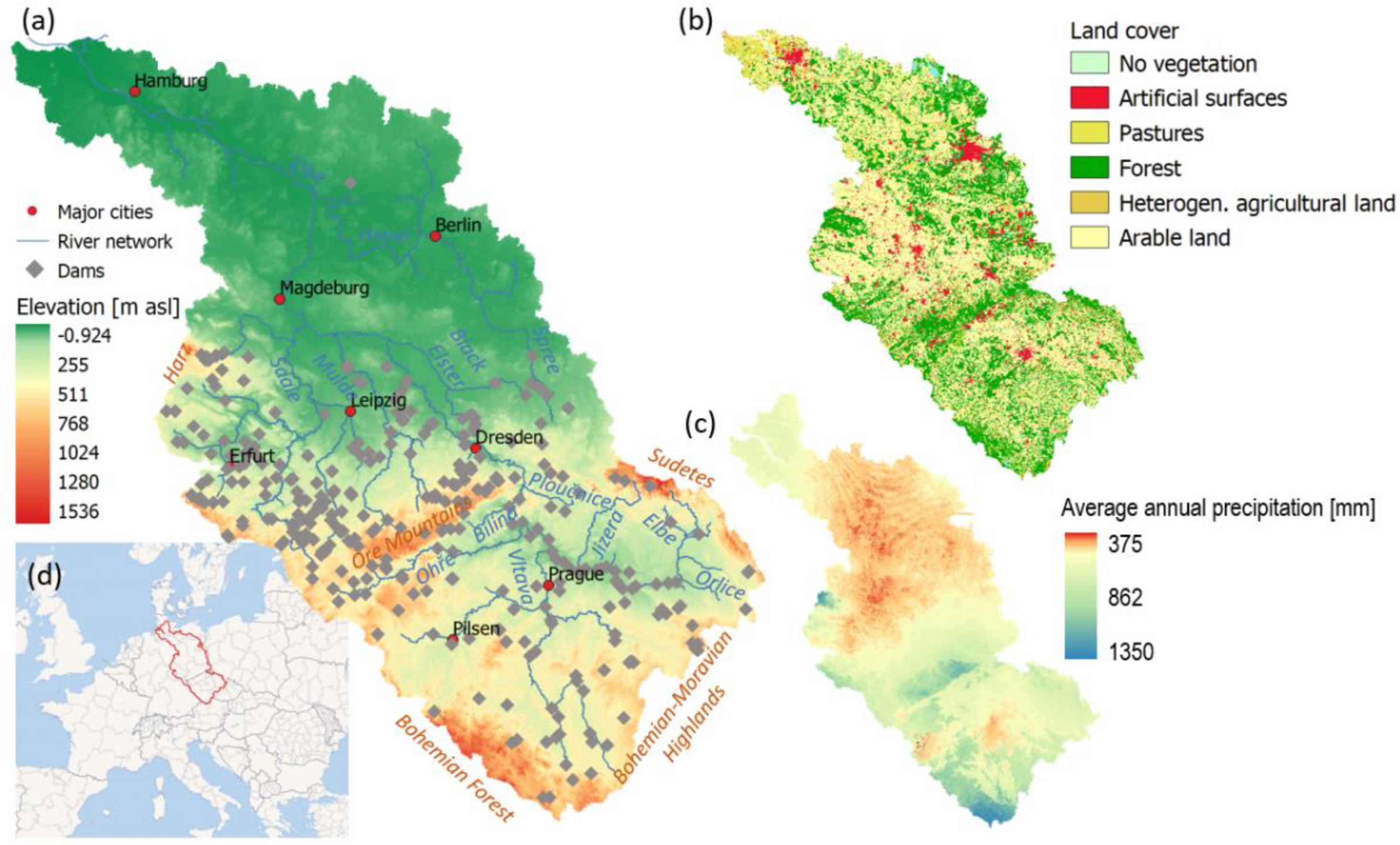
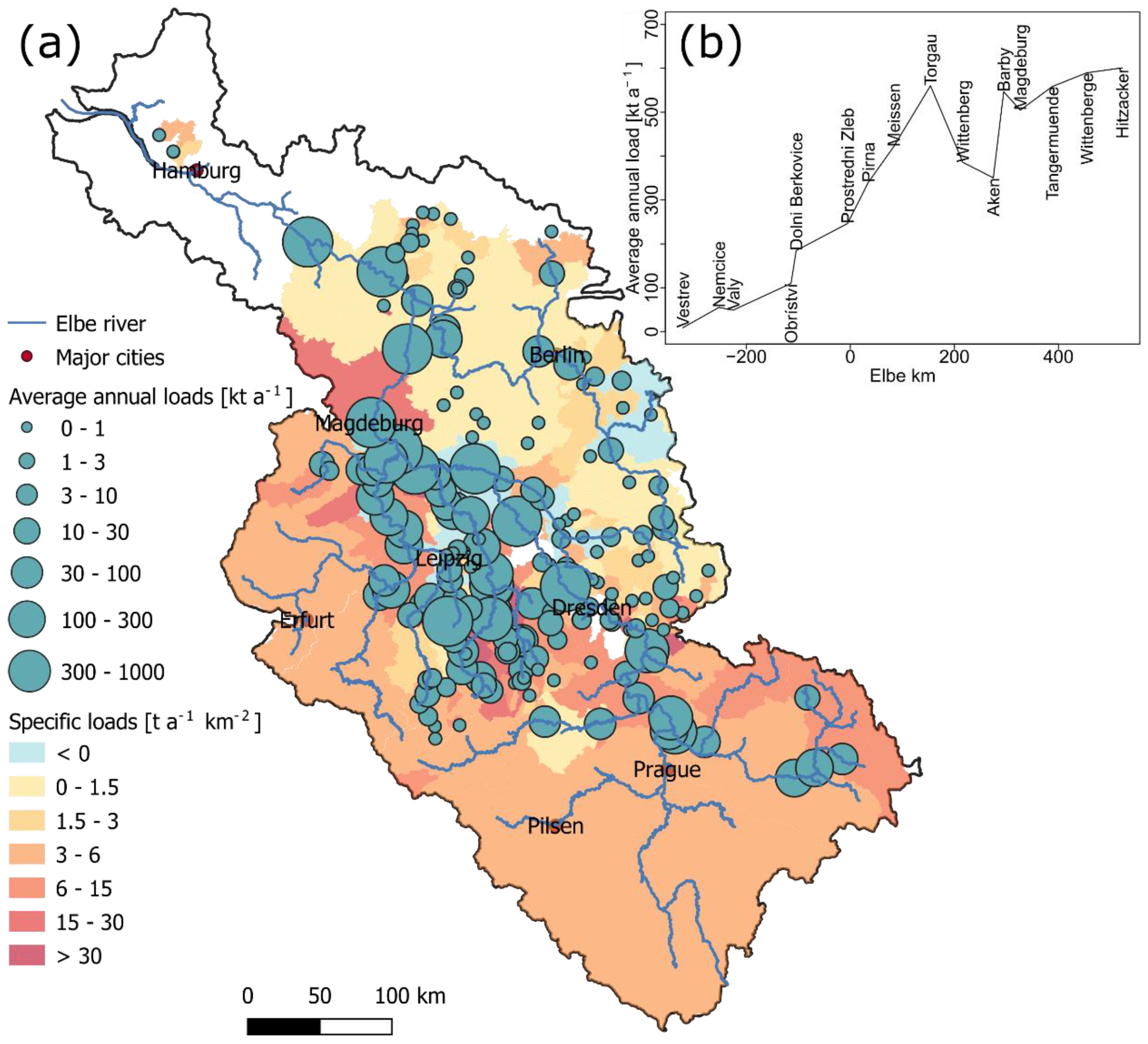
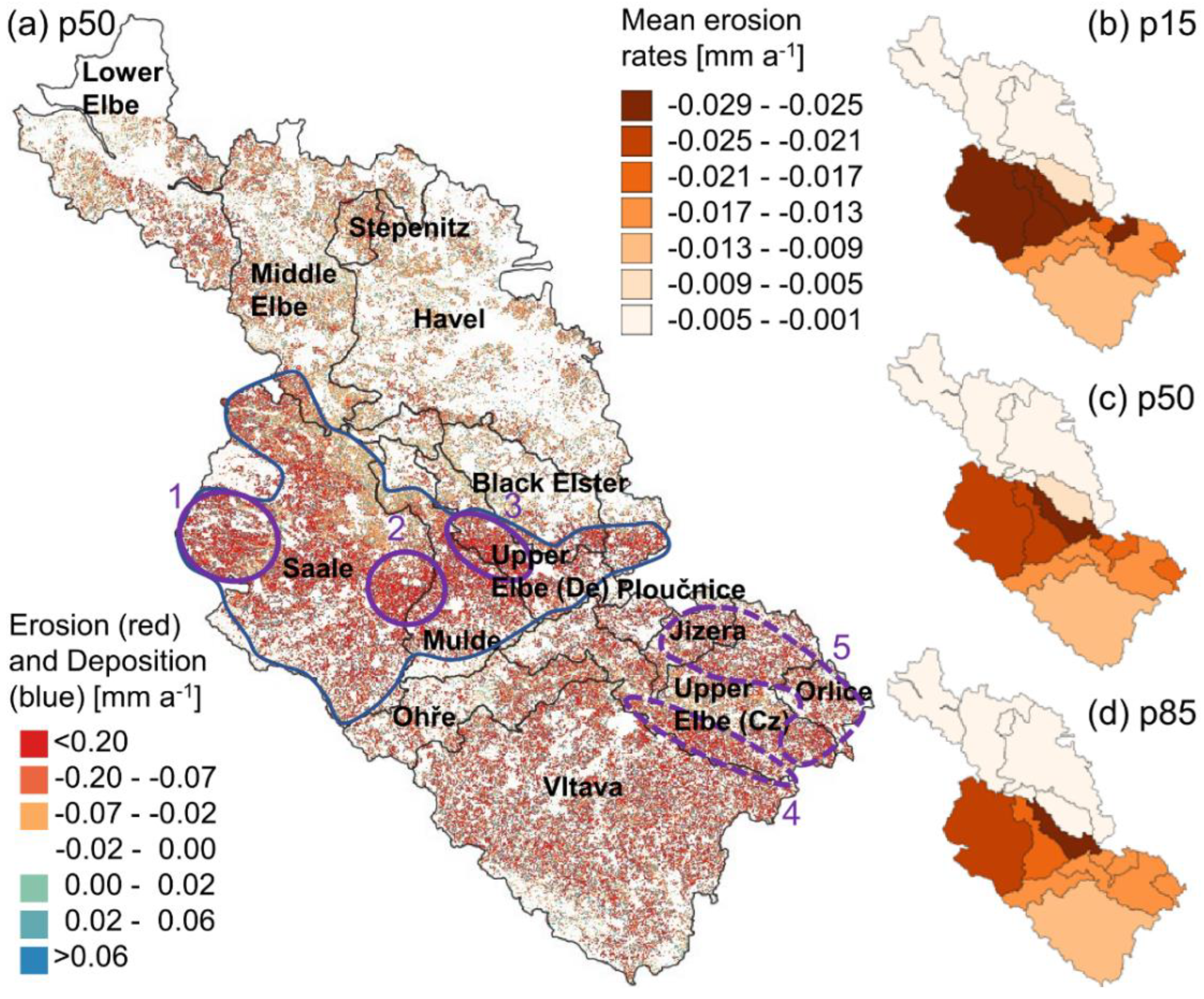
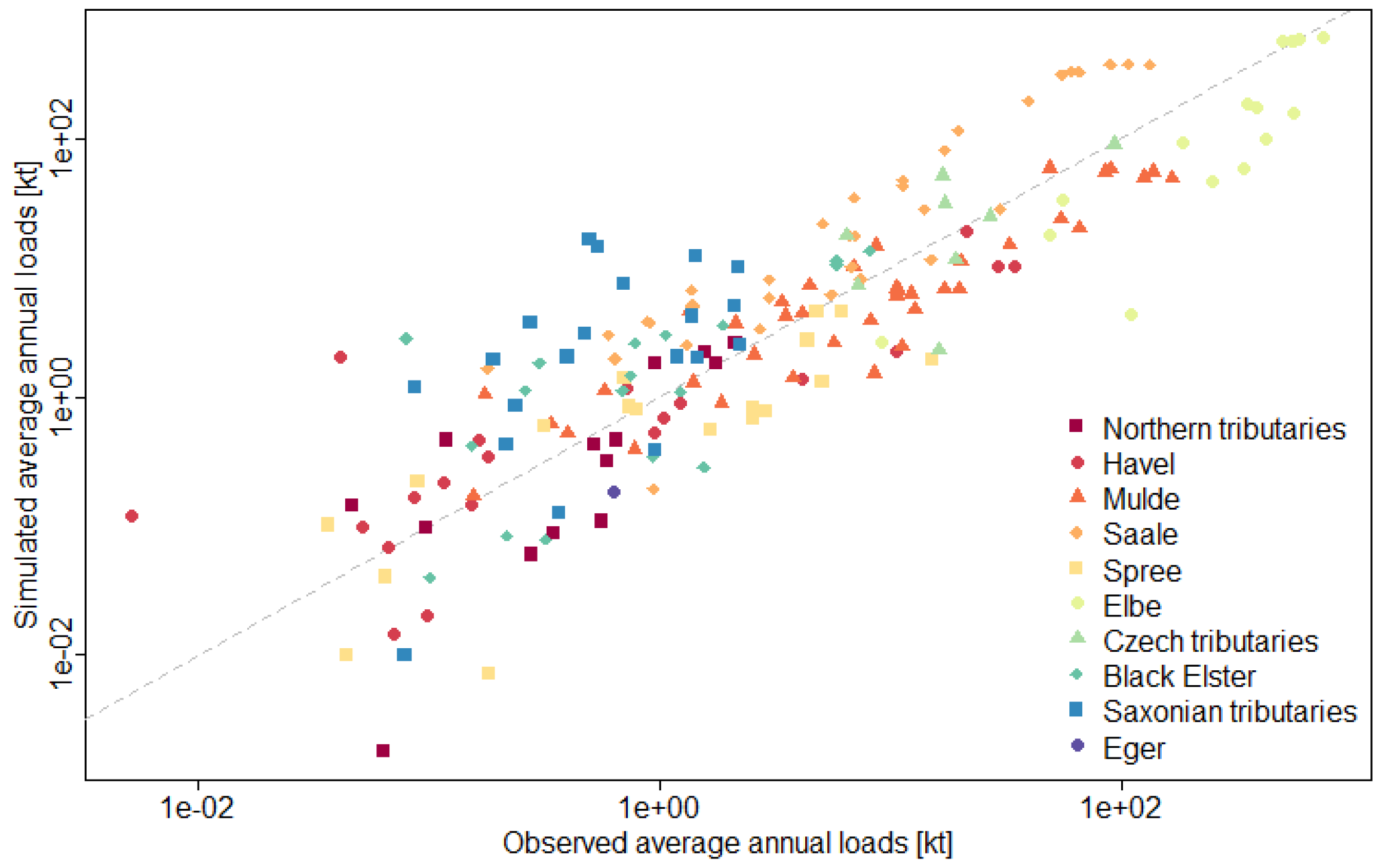
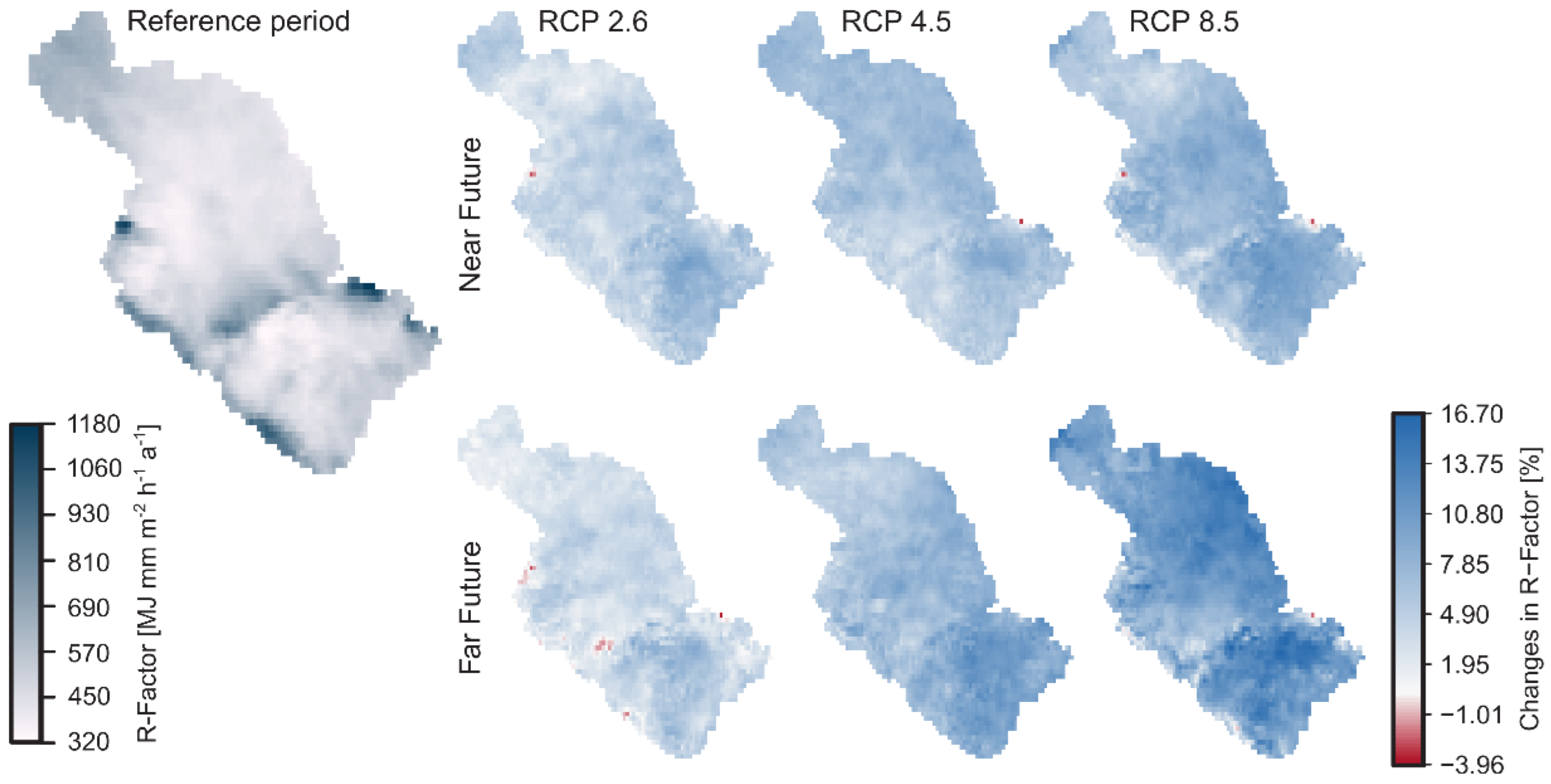
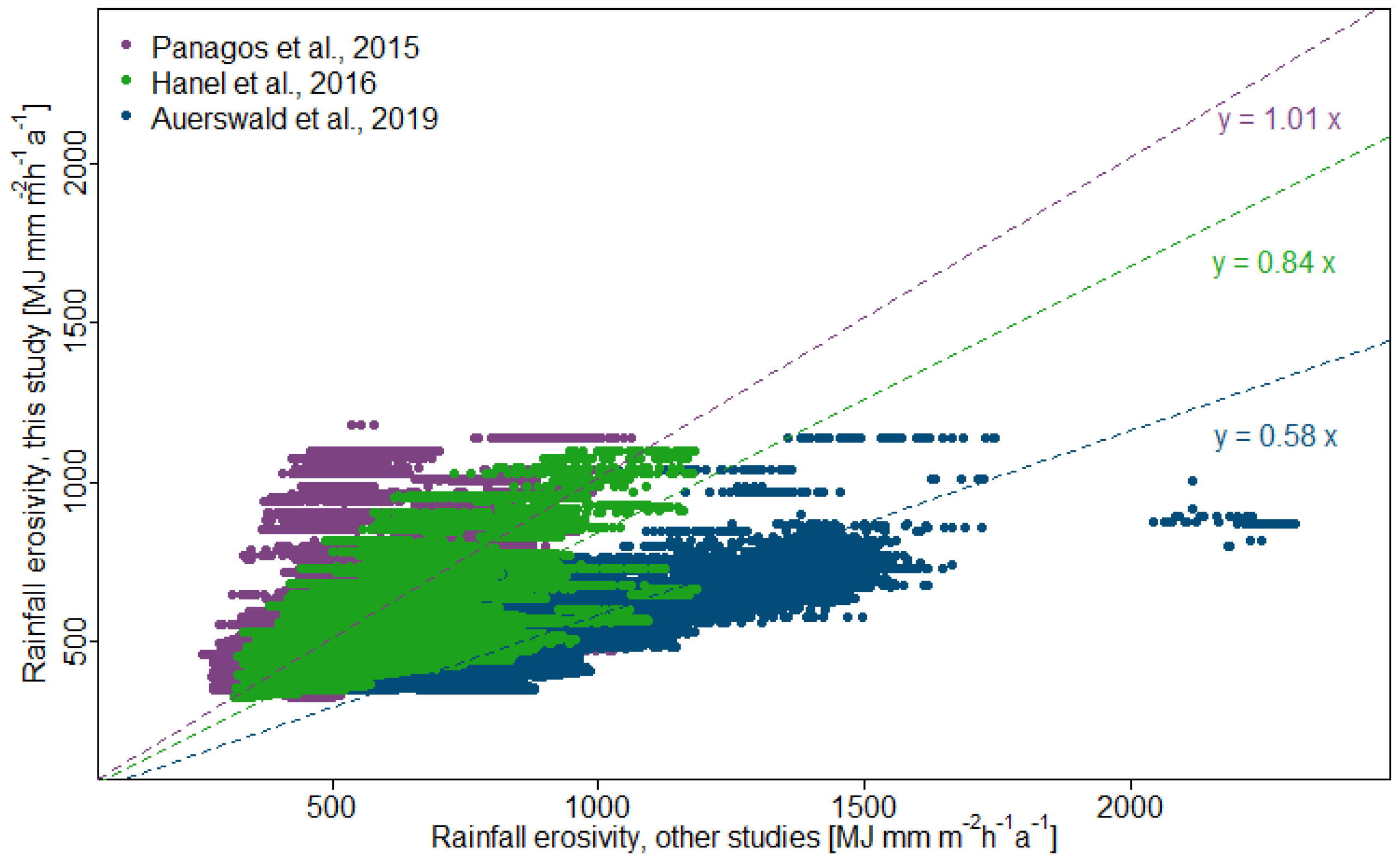
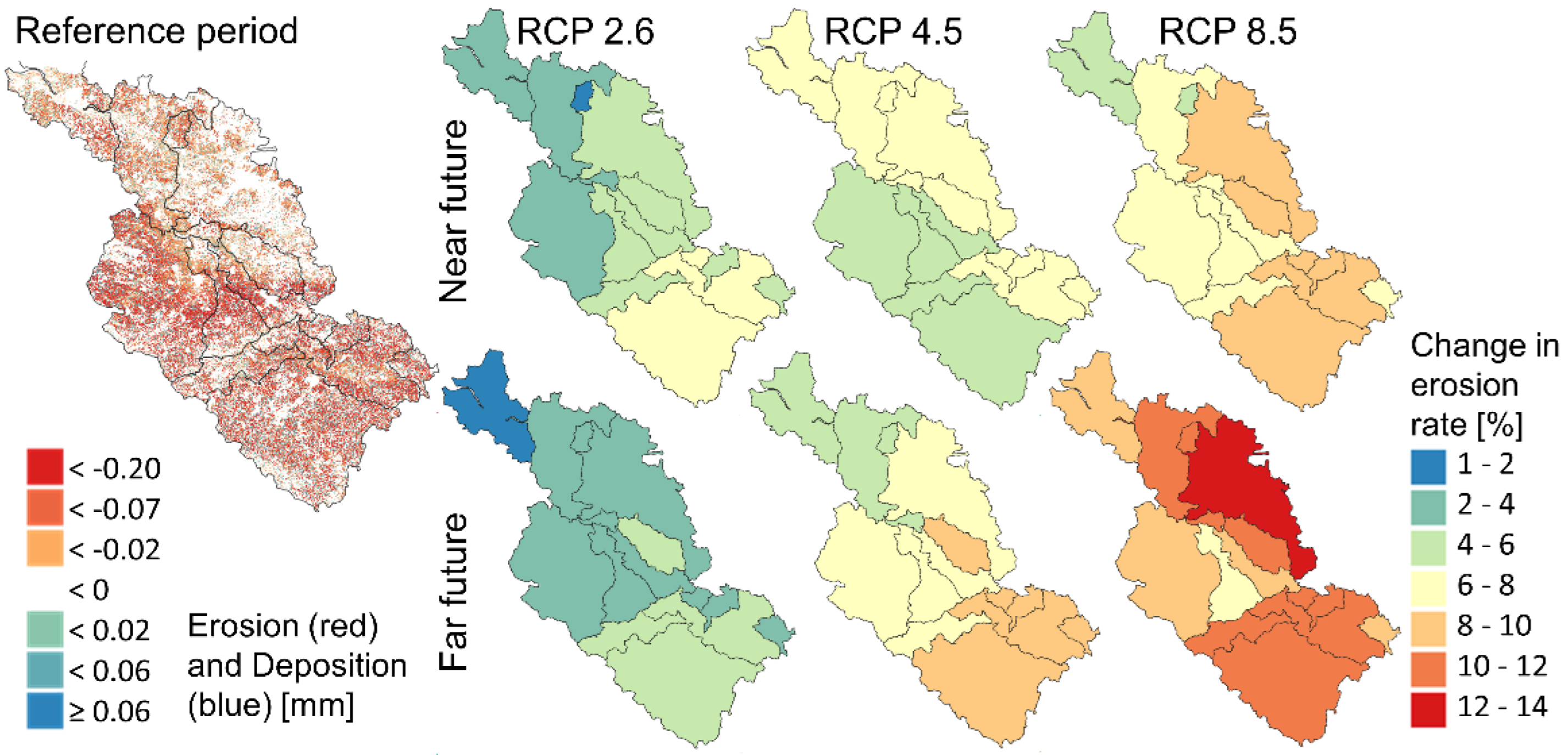

| Spatial Coverage | Measurement Sites | Selected Sites | Measurement Frequency | Start |
|---|---|---|---|---|
| Czech Republic 1 | 10 | 10 | daily | 1993 |
| Czech Republic 2 | 4 | 4 | daily | 2001 |
| Germany 3 | 17 | 14 | on workdays | 1963 |
| Bavaria 4 | 2 | 2 | sub-daily | 2011 |
| Berlin 5 | 6 | 1 | bimonthly-monthly | 1973 |
| Brandenburg 6 | 444 | 45 | usually monthly | 1989 |
| Saxony 7 | >1000 | 88 | weekly-monthly | 1977 |
| Saxony-Anhalt 8 | >1000 | 26 | Bimonthly-monthly | 2007 |
| Schleswig-Holstein 9 | 4 | 3 | usually monthly | 1991 |
| River | Location | ||
|---|---|---|---|
| Upper Elbe | Němčice n. Labem | 55.42 | 13.24 |
| Orlice | Týniště n. Orlicí | 19.05 | 12.77 |
| Jizera | Tuřice | 26.97 | 12.87 |
| Vltava | Zelčín | 93.43 | 3.40 |
| Ohře | Terezín | 16.85 | 3.00 |
| Bílina | Ústí nad Labem | 7.26 | 6.78 |
| Ploučnice | Benešov n. Ploučnicí | 6.49 | 5.60 |
| Saxonian tributaries | - | 16.19 | 7.36 |
| Black Elster | Gorsdorf | 6.07 | 6.07 |
| Mulde | Dessau | 19.93 | 2.78 |
| Saale | Calbe | 107.66 | 4.60 |
| Havel | Rathenow | 34.64 | 0.99 |
| Northern tributaries | - | 4.62 | 1.45 |
| Elbe | Hitzacker | 600.89 | 4.76 |
| NSE [-] | RPIQ [-] | MAE [kt a−1] | Puncb [%] | |
|---|---|---|---|---|
| Calibration | ||||
| Min | 0.51 | 0.78 | 50.329 | 28.788 |
| Max | 0.79 | 2.268 | 85.209 | 42.636 |
| Mean | 0.68 | 1.539 | 63.431 | 35.294 |
| Validation | ||||
| Min | 0.10 | 0.60 | 16.87 | 14.71 |
| Max | 0.96 | 4.07 | 123.40 | 48.39 |
| Mean | 0.59 | 2.10 | 73.07 | 31.93 |
Publisher’s Note: MDPI stays neutral with regard to jurisdictional claims in published maps and institutional affiliations. |
© 2022 by the authors. Licensee MDPI, Basel, Switzerland. This article is an open access article distributed under the terms and conditions of the Creative Commons Attribution (CC BY) license (https://creativecommons.org/licenses/by/4.0/).
Share and Cite
Uber, M.; Rössler, O.; Astor, B.; Hoffmann, T.; Van Oost, K.; Hillebrand, G. Climate Change Impacts on Soil Erosion and Sediment Delivery to German Federal Waterways: A Case Study of the Elbe Basin. Atmosphere 2022, 13, 1752. https://doi.org/10.3390/atmos13111752
Uber M, Rössler O, Astor B, Hoffmann T, Van Oost K, Hillebrand G. Climate Change Impacts on Soil Erosion and Sediment Delivery to German Federal Waterways: A Case Study of the Elbe Basin. Atmosphere. 2022; 13(11):1752. https://doi.org/10.3390/atmos13111752
Chicago/Turabian StyleUber, Magdalena, Ole Rössler, Birgit Astor, Thomas Hoffmann, Kristof Van Oost, and Gudrun Hillebrand. 2022. "Climate Change Impacts on Soil Erosion and Sediment Delivery to German Federal Waterways: A Case Study of the Elbe Basin" Atmosphere 13, no. 11: 1752. https://doi.org/10.3390/atmos13111752
APA StyleUber, M., Rössler, O., Astor, B., Hoffmann, T., Van Oost, K., & Hillebrand, G. (2022). Climate Change Impacts on Soil Erosion and Sediment Delivery to German Federal Waterways: A Case Study of the Elbe Basin. Atmosphere, 13(11), 1752. https://doi.org/10.3390/atmos13111752







